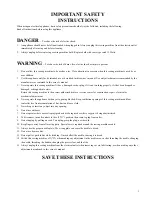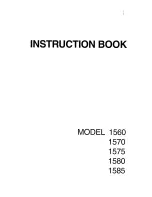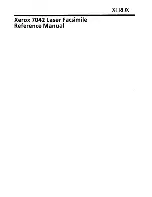
INFORMATIONS IMPORTANTES DE SÉCURITÉ
Quand vous utilisez la machine à coudre, les précautions de base doivent toujours
être suivies, incluant ce qui suit.
“Lire toutes les instructions avant usage.”
DANGER
-
Pour réduire tout risque de choc.
1. La machine ne doit jamais être utilisée sans surveillance lorsque branchée. Toujours débrancher la
machine à coudre de la prise de courant dès la fin de l’utilisation ou avant nettoyage.
AVERTISSEMENT-
Pour réduire les risques de brûlures, feu, choc électrique ou blessure
aux personnes
1. Ne pas permettre d’être utiliser comme un jouet. Une surveillance continuelle est nécessaire quand
la machine est utilisée par ou près des enfants.
2. Utilisez seulement la machine tel que décrit dans ce manuel. Utilisez seulement les accessoires
recommandés par le fabricant.
3. Ne jamais utiliser la machine si le cordon ou la prise électrique sont endommagés , en cas de
dysfonctionnement, de bris ou de dégâts d’eaux, vous devez la retourner chez votre revendeur
BABY LOCK ou au centre de service le plus proche pour vérification, réparation, ajustement
mécanique ou électrique.
4. Ne jamais utiliser la machine si la circulation d’air est bloquée. Toujours garder les ouvertures de
ventilation de la machine et du rhéostat libre de poussières, peluches ou tissus.
5. Ne jamas insérer ou laisser tomber tout objet dans toute ouverture.
6. Ne pas utiliser à l’extérieur.
7. Ne pas utiliser dans les endroits où des produits aérosols ou d’oxygène sont employés.
8. Pour déconnecter, mettre l’interrupteur principal au symbole “O” qui représente “OFF” puis enlever
la prise de la prise de courant.
9. Ne pas déconnecter en tirant sur la cordon. Pour déconnecter, tirer sur la prise et non pas sur la
cordon.
10. Gardez vos doigts au loin de toutes parties fonctionnelles. Des soins spéciaux sont demandés
autour de l’aiguille.
11. Toujours utiliser la bonne plaque d’aiguille. La mauvaise plaque peut occasionner la cassure de
l’aiguille.
12. Ne jamais utiliser des aiguilles crochues.
13. Ne pas tirer ou pousser le tissu pendant que vous cousez. Cela peut détourner l’aiguille et la
briser.
14. Mettre la machine dans la position “O” quand vous faites des ajustements dans la région de
l’aiguille, comme l’enfilage, le changement d’aiguille, le changement de pied, et ainsi de suite.
15. Toujours débrancher la machine à coudre quand vous enlevez les couvercles, faites la lubrification
ou tout autre ajustement d’entretien selon le livre d’instructions.
16. Gardez vos doigts loin des parties amovibles, spécialement la région près des lames.
17. Veuillez noter, pour disposer de ce produit il doit être recyclé en conformité avec le registre de la
législation Nationale applicable aux produits électriques et électroniques. Si dans le doute, contactez
votre revendeur pour obtenir des conseils.
18. L'appareil n'est pas conçu pour être utilisé par de jeunes enfants ou des personnes
à mobilité réduite sans surveillance.
19. Les jeunes enfants doivent être surveillés afin de s'assurer qu'ils ne jouent pas avec l'appareil.
20. Cet appareil n'est pas destiné à être utilisé par des personnes (notamment des en-fants) dont les
capacités physiques, sensorielles ou mentales sont réduites ou le manque d'expérience et de
connaissances, à moins qu'elles n'aient été formées et encadrées pour l'utilisation de cet appareil
par une personne responsable de leur sécurité.
21.-Pièces en mouvement- Fermez le couvercle avant de faire fonctionner la machine.
“CONSERVEZ CES INSTRUCTIONS”
“Cette machine à coudre est conçue pour usage
domestique.”
Summary of Contents for Acclaim BLES4
Page 1: ......
Page 5: ...C O N G R A T U L A T I O N S 2 Notes...
Page 19: ...O V E R V I E W 16 Notes...




































